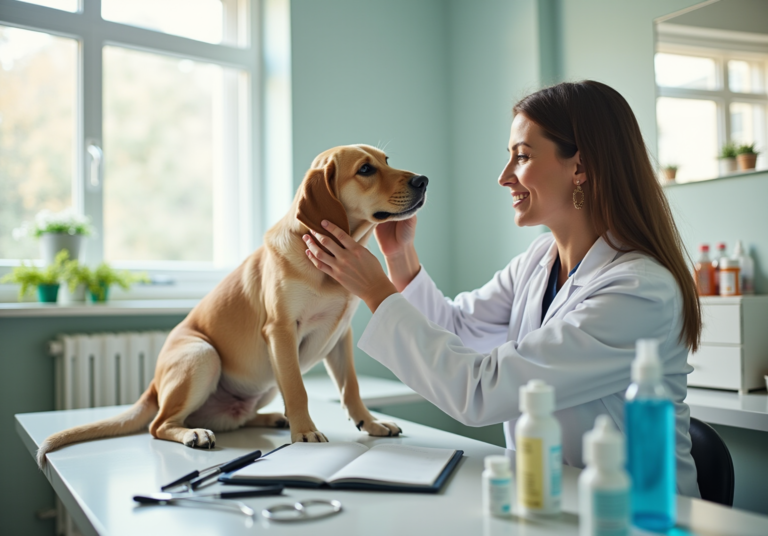4 Steps to Address Dog Eye Infection Effectively
Overview
To effectively address a dog eye infection, it’s essential to recognize the symptoms, follow diagnostic procedures, implement appropriate treatments, and adopt preventive care measures. Early identification of symptoms is crucial, as it allows for timely intervention. Consulting a veterinarian for accurate diagnosis and treatment is a vital step in ensuring your furry family member receives the best care possible. Additionally, maintaining ongoing eye health through regular check-ups and cleanliness fosters a nurturing environment that promotes the well-being of your beloved pet. Together, these actions contribute to a happier and healthier life for your dog.
Introduction
In the world of pet care, the health of your furry family members’ eyes is often overlooked, yet it is vital for their overall well-being. Dog eye infections can stem from various causes, such as allergies or foreign bodies, and recognizing the symptoms early can significantly impact treatment outcomes.
By understanding how to diagnose, treat, and prevent these infections, you can not only facilitate a swift recovery but also enhance the quality of life for your beloved companions.
This article explores the essential aspects of dog eye infections, equipping pet owners with the knowledge needed to safeguard their pets’ vision and health.
Recognize Symptoms and Causes of Dog Eye Infections
To effectively address a dog eye infection, it’s crucial to begin by identifying the common symptoms that may worry you as a pet owner. Look for signs of a dog eye infection such as:
- Redness or swelling around the eyes.
- Discharge that may be clear, yellow, or green.
- Excessive tearing or watery eyes.
- Squinting or reluctance to open the eye.
- Pawing at the eye or rubbing against surfaces.
Understanding these symptoms of dog eye infection is crucial. Common causes of dog eye infections can include:
- Bacterial or viral infections.
- Allergies to environmental factors like pollen or dust.
- Foreign bodies such as dust or grass seeds.
- Underlying health issues like autoimmune diseases.
By being vigilant about these signs, you can ensure timely veterinary intervention for your dog’s recovery, which is critical for your furry family member. Remember, your attentiveness can make all the difference in their healing journey.

Follow Diagnostic Steps for Eye Infections
When you notice symptoms in your furry family member, it’s important to take the right steps to ensure their well-being. Here’s how you can navigate this process with care:
- Schedule a Veterinary Appointment: Reach out to your veterinarian to discuss your pet’s symptoms and arrange for a thorough examination. Your concerns matter, and the vet is there to help.
- Prepare for the Visit: Take a moment to note any changes in your pet’s behavior, diet, or environment that may have contributed to their discomfort. This information can be invaluable during the visit.
- During the appointment, the vet will conduct a careful examination of your dog’s eyes to check for any signs of a dog eye infection, such as redness, discharge, or foreign objects. This thoroughness is essential for identifying the issue.
- Diagnostic Tests: Depending on the initial findings, your veterinarian may suggest specific tests to get to the root of the problem. These might include:
- Fluorescein staining to check for corneal ulcers.
- Tear production tests to assess for dry eye conditions.
- Culture tests to identify specific bacteria or fungi.
By following these compassionate steps, you can provide your veterinarian with the valuable information they need to make an accurate diagnosis and create a tailored treatment plan. Remember, you’re not alone in this journey; your pet’s health is our priority, and together, we can ensure they receive the care they deserve.

Implement Effective Treatment Options
After your pet’s diagnosis, it’s natural to seek the best treatment options to help your furry family member feel better. Here are some potential paths to consider:
- Antibiotics: If a bacterial infection is confirmed, your veterinarian will prescribe oral or topical antibiotics to combat the issue.
- Anti-inflammatory medications: These can be invaluable in reducing swelling and discomfort for your beloved companion.
- Eye drops or ointments: Depending on the specific ailment, your vet may recommend tailored eye drops to soothe irritation and promote healing.
- Home Care: You can play a vital role in your dog’s recovery by:
- Gently cleaning the eye area with a damp cloth to remove any discharge.
- Applying warm compresses to alleviate discomfort and provide comfort.
- Ensuring your dog refrains from rubbing or scratching the affected eye, keeping them safe and sound.
It’s essential to always follow your veterinarian’s instructions regarding medication dosages and application methods. This will ensure effective treatment and help your furry friend on their path to recovery.

Adopt Preventive Care for Dog Eye Health
To help your furry family members avoid future dog eye infections, consider these nurturing care strategies:
- Regular Veterinary Check-ups: Schedule annual exams to keep a watchful eye on your dog’s overall health and eye condition.
- Maintain Cleanliness: Regularly clean the area around your dog’s eyes to prevent the buildup of dirt and discharge, ensuring their comfort and well-being.
- Protect from Allergens: Limit exposure to known allergens and irritants, such as pollen and dust, to keep your pet’s eyes safe and healthy.
- Use Protective Gear: If your dog is prone to eye injuries, think about using protective goggles during outdoor adventures to shield their precious eyes.
- Healthy Diet: Ensure your dog enjoys a balanced diet rich in vitamins and minerals that support eye health, including omega-3 fatty acids, for optimal wellness.
By embracing these preventive measures, you can create a nurturing environment that helps ensure your dog’s eyes remain healthy and free from dog eye infections.

Conclusion
Recognizing the symptoms and causes of dog eye infections is the first step in safeguarding the vision and health of your furry family members. By being vigilant for signs such as redness, discharge, and excessive tearing, you can facilitate timely veterinary intervention. Understanding the common causes, including bacterial infections and allergies, empowers you to act quickly, ensuring a better outcome for your beloved pets.
Following a structured diagnostic process is essential for effective treatment. Scheduling a veterinary appointment and providing detailed information about symptoms can aid in accurate diagnosis. Diagnostic tests may reveal underlying issues, allowing for tailored treatment options that may include:
- Antibiotics
- Anti-inflammatory medications
- Home care strategies
Preventive care plays a crucial role in maintaining eye health. Regular veterinary check-ups, cleanliness, and protection from allergens are simple yet effective strategies that can significantly reduce the risk of future infections. A balanced diet also contributes to overall eye health, ensuring that your pets can enjoy a vibrant life.
In conclusion, prioritizing eye health in dogs not only enhances their quality of life but also fosters a deeper bond between you and your furry companions. By being proactive in recognizing symptoms, pursuing proper diagnosis and treatment, and adopting preventive measures, you can protect your beloved friends from the discomfort and complications associated with eye infections. Ultimately, informed and attentive care leads to happier, healthier companions.
Frequently Asked Questions
What are the common symptoms of a dog eye infection?
Common symptoms include redness or swelling around the eyes, discharge that may be clear, yellow, or green, excessive tearing or watery eyes, squinting or reluctance to open the eye, and pawing at the eye or rubbing against surfaces.
What causes dog eye infections?
Dog eye infections can be caused by bacterial or viral infections, allergies to environmental factors like pollen or dust, foreign bodies such as dust or grass seeds, and underlying health issues like autoimmune diseases.
Why is it important to identify symptoms of a dog eye infection?
Identifying symptoms is crucial for ensuring timely veterinary intervention, which is critical for your dog’s recovery and overall health.
How can a pet owner help their dog recover from an eye infection?
By being vigilant about the signs of eye infections and seeking prompt veterinary care, pet owners can significantly aid in their dog’s healing journey.



